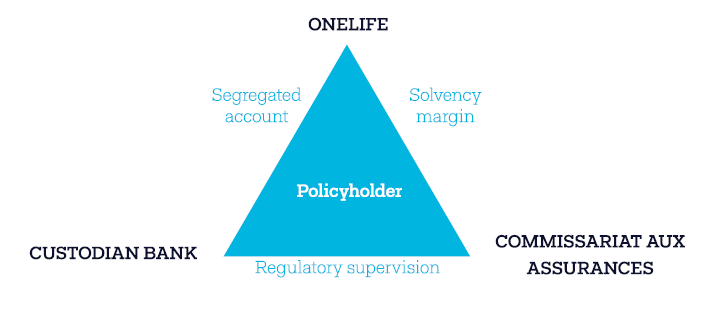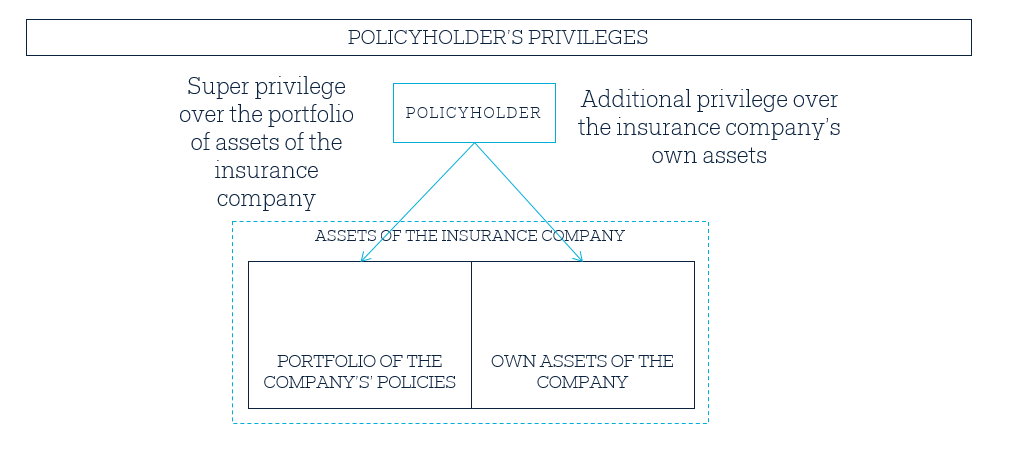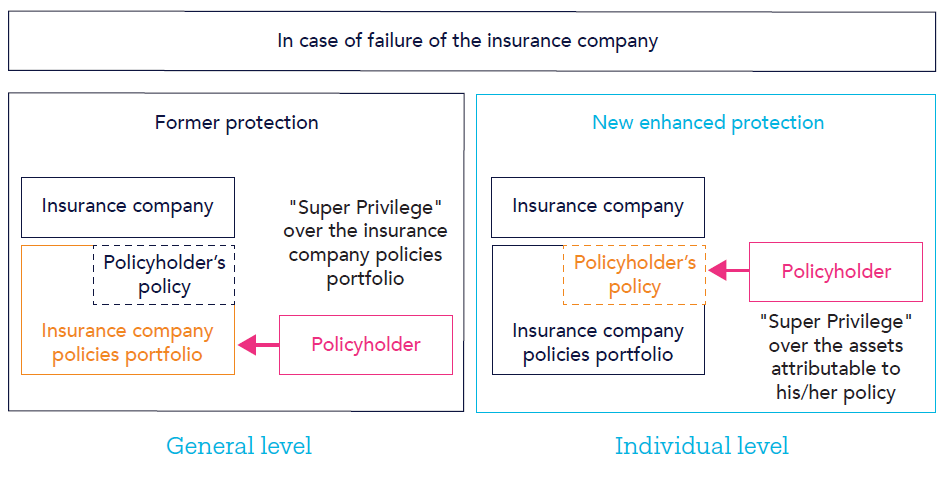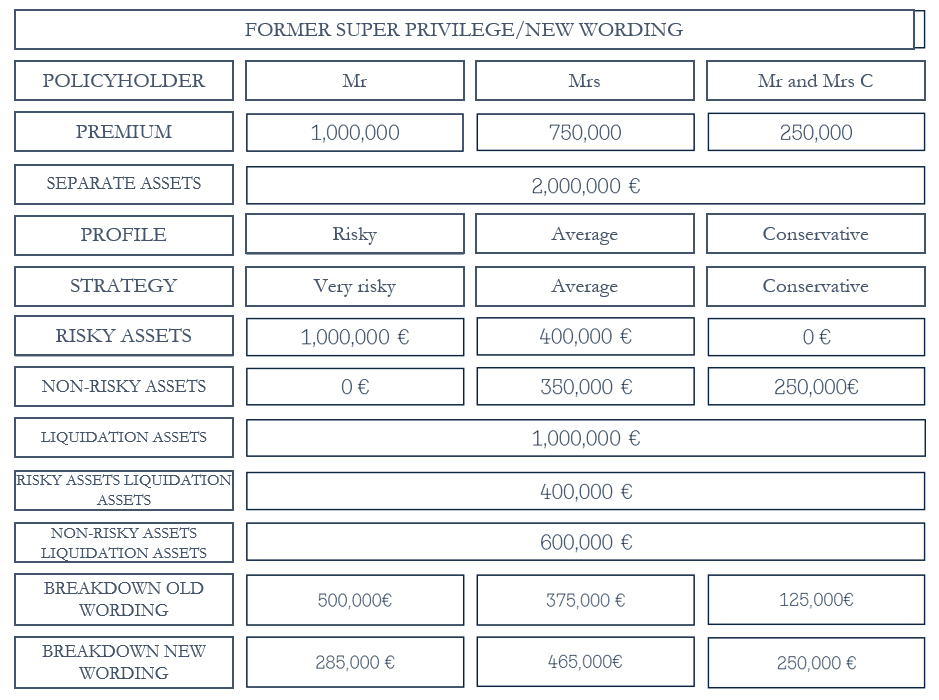October 29, 2018
A concept which forms the basis of the Luxembourg life assurance solution, the Triangle of Security, is promoted by many Luxembourg life assurance companies, is often used, almost over-used, and is often poorly explained.
Here are some explanations of the principle and a look at the modifications originating from the law of 10 August relating to the distribution of insurance (hereinafter the “IDD Law”).
- The principle: protection for all
Indeed, the protection of wealth and assets currently figures among the main preoccupations of wealthy clients and their family.
The legal framework of the Luxembourg insurance sector offers unique wealth protection for policyholders thanks to:
- the regime protecting policyholders, i.e. the “Triangle of Security”
- the protection against any bankruptcy of the insurance company
- the protection against seizure of the claim of the policyholder by third parties
1.1 What is the Triangle of Security?

Originating from the law on the insurance sector, the Triangle of Security is a legal mechanism centred on the policyholder enabling segregation of the assets and strict control over these via the signing of a tri-partite deposit agreement between the Insurance Commission (hereinafter the “CAA”), the life assurance company and the custodian bank representing the three sides of the triangle.
Thus, on the one side, Luxembourg life assurance companies are obliged to deposit all the assets linked to life assurance polices (the “technical provisions”) in the accounts of an independent custodian bank, this is side 1 of the triangle.
These assets must be separated from the insurance company’s and the bank’s capital.
On the other side, the custodian bank must be approved beforehand by the Luxembourg insurance sector regulatory body, the CAA; this is side 2 of the triangle.
Lastly, the CAA, in respect of the custodian bank and the insurance company, has regulatory powers of control, investigation and sanctions (side 3).
1.2 Protection against potential bankruptcy of the insurance company
In the event of financial difficulties for the insurance company, the CAA may use the powers which are provided for in articles 116 et seq of the law of 7 December 2015 (hereinafter the “Law”) in respect of the custodian banks, i.e.
- The CAA may notably impose a freeze on the separate accounts linked to the insurer’s technical provisions in favour of the policyholders and the beneficiaries. Consequently, from this date onwards, no further transactions may be carried out on these accounts without the CAA’s prior authorisation (whether by the insurer or by the bank). The CAA may also, where applicable, sell all liquid assets or registration of a mortgage on fixed assets.
- Article 118 of the Law provides that policyholders have first-rank preferential rights over the assets in separate accounts, a “Super Privilege” thanks to which they have priority over all the other creditors of the insurance company (employees, etc.).
- In the event of insufficient assets on the separate accounts, article 119 of the Law provides that policyholders have additional privileged rights over the insurance company’s own assets. They are, however, primed in this privilege by legal and liquidation costs, employees’ privilege and accident liabilities and that of the Treasury and of the Communes.

1.3. Protection against the seizure of the policyholder’s claim by third parties
Articles 114 et seq of the Luxembourg law on insurance policies of 27 July 1997 stipulate that the rights to redeem, advance and pledge the policyholder’s policy belong only to the latter; these rights may not, therefore, be seized or exercised by a policyholder’s third-party creditor.
The policyholder’s creditors may not, therefore, force the holder to exercise these rights.
The policyholder’s creditors may not seize the policy itself since it legally belongs to the insurance company.
The policyholder’s creditors are likely to seize the latter’s claim from the insurance company in order to recover their claim, but they will receive no payment from the insurance company unless the policyholder has decided freely to exercise its rights to redeeming the policy.
The only exception to this principle is the payment by the policyholder of manifestly exaggerated premiums in respect of the holder’s resources and assets.
2. Modifications to the framework of protection of the assets by the IDD Law

The legal protection framework, already very protective, has been further reinforced by the addition of rules individualising protection based on the policyholder’s profile and strategy.
The application that may have been made of the rules, may have led to an unfair result for policyholders and the CAA has rightly clarified these rules.
As previously, article 253 of the Law lays down the value of the separate assets on the day of opening of the liquidation procedure.
The former wording of the super privilege laid down a general super privilege on the separate assets of the life assurance company.
The new wording resulting from articles 253-1 and 253-5 of the Law lays down a super privilege on the policyholder’s units of account in an underlying asset, i.e. the number of underlying units of the policyholder himself.

Since an example with figures is better than a long explanation, let’s take the example of Mr Abra Racourcix (Mr A), Mrs Alie Bonnemine (Mrs B), Mr and Mrs John and Mary Charic (Mrs and Mrs C).
Mr A is a gambler, he wants a high return (whatever the risk, he says); he invests only in high-return but high-risk A shares
Mrs B has a conservative profile, she looks for return but without wishing to take every risk; she invests both in risky assets and low-risk assets
Mr and Mrs C don’t like risk. They have a more conservative profile and wish to invest in less risky assets, even if the return is lower.

Under the old wording of the super privilege, the proportionate breakdown could have led to an unfair result for Mr and Mrs C whereas Mr A would have been “recompensed” for the risks incurred.
The new wording “follows” the assets of the policies and breaks down more fairly the sums to be recovered by individualising the protection, each policy being considered as an individual cell on which the super privilege is exercised.
It is thus a measure which further reinforces the incomparable benefit of Luxembourg life assurance for wealthy clients and their family, in addition to the incomparable stability, transparency and investment possibilities of the Luxembourg policy!
To find out more, watch this video!
OneLife is at partners’ and its clients’ side for any question relating to the legal framework of protection for life assurance policyholders.
![]() Jean-Nicolas GRANDHAYE – Corporate Counsel
Jean-Nicolas GRANDHAYE – Corporate Counsel
